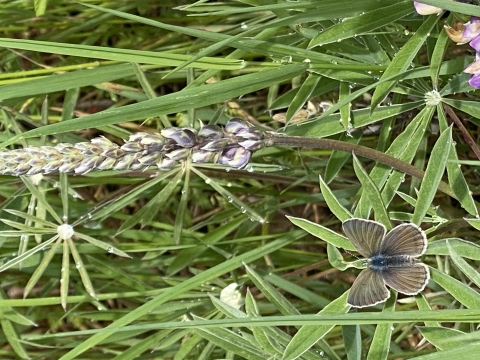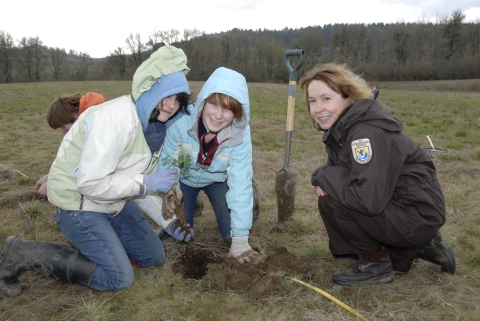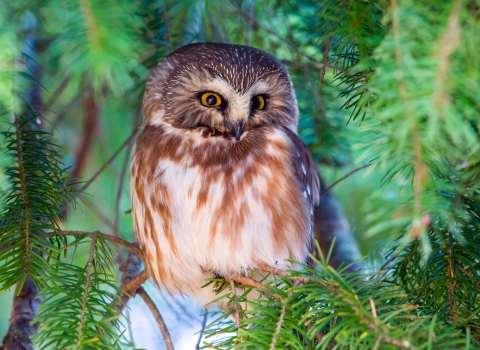What does it take to save an endangered species? Faith, trust, and a little bit of pixie dust? Pardon the pun, but you don’t just “wing” it. There is a lot of time, planning, blood, sweat, tears, lessons learned, and teamwork involved in species recovery. And, okay, there might be a little “magic” in it too.
Fender’s blue butterfly (Icaricia icarioides fenderi) has experienced this magic firsthand. A member of the Lycadenidae (gossamer-wings) family, this butterfly was first described in 1931, based on a specimen collected west of Salem, Oregon.
Much like a mythical fairy, little was known about this mysterious beauty. By 1937, Fender’s blue butterfly was nowhere to be found. Extinct, or so it seemed, until it was rediscovered a half century later by scientist, Dr. Paul Hammond.
Fender’s blue butterfly is endemic to the Willamette Valley in northwest Oregon. Take a walk through the valley’s upland prairies and oak savannahs during May or June and you might be lucky enough to spot one. Maybe. These 1-inch wonders are often confused with the closely-related silvery blue butterflies (Glaucopsyche lygdamus). In fact, you can only really tell the difference by comparing the spotting pattern under their wings.
Like other prairie-dependent species in the valley, Fender’s blue butterfly has weathered some hard times. Once abundant with prairies, wetlands, and upland oak habitat, the Willamette Valley has been largely altered by development and decades of fire suppression.
In 2000, the U.S. Fish and Wildlife Service listed Fender’s blue butterfly as endangered under the Endangered Species Act. At the time only 32 sites were known and its habitat was continuing to decline through the natural process of succession. By nature, prairies are transient communities, requiring disturbance to prevent them from turning into forests. With fire suppression, disturbances that previously maintained native prairies have been altered, allowing invasive weeds and native tree and shrub species to shade out low-growing lupine, a plant upon which this butterfly depends.
Over the past 20 years, the Service has worked diligently with landowners, conservation agencies, businesses, and other agencies in the region to conserve Fender’s blue butterfly. Together, we have restored and maintained habitat by mimicking natural disturbance through mowing, prescribed fire, and other methods. This disturbance is closely followed with seeding or planting plugs of this butterfly’s host plant and native flowers that provide nectar for this and other pollinators. This effort has been a major collaboration among a large group of diverse stakeholders –the Natural Resources Conservation Service, Bureau of Reclamation, Army Corps of Engineers, our Willamette Valley National Wildlife Refuges and Partners for Fish and Wildlife Program, Benton County Parks, Institute of Applied Ecology, Washington State University, Greenbelt Land Trust, The Nature Conservancy, and numerous private landowners, among others.
Thankfully, the planning, doing, learning, and sometimes redoing, is working because partnerships make conservation possible. The combination of prairie conservation, habitat management, and monitoring efforts has given Fender’s blue butterfly a “wing up.”
While the beauty and magic is in the partnerships, the evidence is in the numbers:
- Fender’s blue butterfly now inhabits twice the acreage it did when listed as endangered in 2000;
- Its known range has grown from four counties to six; and
- The number of known occupied sites has quadrupled!
Another important number in this story is 95. More specifically, at least 95% of land within the Willamette Valley is privately owned, so voluntary, cooperative approaches are key to long-term conservation for this butterfly and other species. To date, 17 landowners have enrolled in Safe Harbor Agreements to help Fender’s and other prairie species and another dozen more agreements are in the works. Many of these landowners are working with Willamette Valley Refuges and the Partners for Fish and Wildlife Programs to improve and maintain prairie habitat on their private lands. It’s a beautiful partnership that brings collective resources to the table while providing management flexibility and regulatory certainty to landowners.
Because of these valuable partnerships, the Service is pleased to announce the reclassification of Fender’s blue butterfly from endangered to threatened. As we celebrate the 50th anniversary of the Endangered Species Act this year, conservation of this butterfly and other Willamette Valley species serves as a prime example of how innovative partnerships and the ESA effectively work together to protect imperiled species and habitats upon which they depend. The ESA has been highly effective and credited with saving 99% of listed species from extinction.
Although Fender’s blue butterfly’s conservation story is not yet complete, these collaborative efforts have propelled this rare butterfly from near extinction to well on its way to recovery. Given a bit more time, and continued commitment to maintain and restore prairie habitat in the valley, this butterfly just might get its fairy-tale ending.








